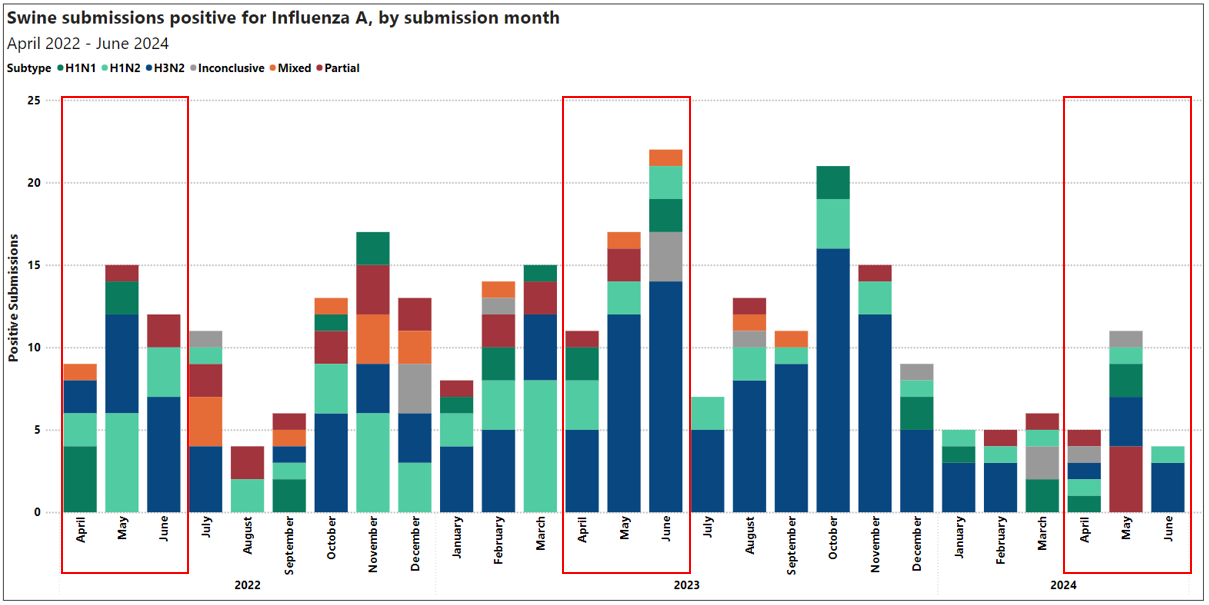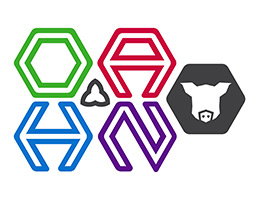Ontario Animal Health Network (OAHN) Swine Network Quarterly Industry Report
Novel Influenza A- H3N2 Cluster 2010.1 Update
Practitioners perceived a continuation of a lower Influenza A virus (IAV) prevalence this quarter in comparison to Q4 of 2023. There were fewer positive submissions in Q2 2024 compared to Q2 of 2023 (50). H3N2 made up a smaller proportion of positive submissions (35%) in Q2 of 2024 compared to Q2 of 2023 (62%) and 2022 (42%). This quarter also had a higher proportion of partially subtyped cases (25%) compared to previous Q2’s (6% in 2023 and 8% in 2022). Most Influenza detections this quarter were in submissions from nursery pigs, followed by grow-finish submissions. When sequenced, most submissions this quarter were in the H3N2 2010.1 cluster. It is speculated that the implementation of an updated regional influenza autogenous vaccine in January 2024, which now includes the extremely dominant H3N2 2010.1 strain, may have reduced the overall prevalence of IAV cases during Q2 of 2024.

Porcine Epidemic Diarrhea (PEDV)/ Porcine Deltacoronavirus (PDCoV)
Jessica Fox from Swine Health Ontario (SHO) provided an update on the Porcine Epidemic Diarrhea (PED) and Porcine Deltacoronavirus (PDCoV) cases in Ontario this quarter. During Q2 of 2024, there were 7 new cases of PDCoV – two sow barns, two nurseries, and three finishers. In addition, there were 13 new cases of PED reported – three sow barns, one gilt barn, five nurseries, and four finishers. Of these 20 new cases, 10 were from movement-related cases originating from known-positive sites. In an effort to help reduce the prevalence of these cases, a working group consisting of Ontario swine vets has been created to help identify and address industry risk points.
SHO encourages members of the industry to be vigilant in the face of this outbreak and continues to support elimination as the best strategy for disease control. Producers are encouraged to continue to be diligent in testing for these coronaviruses in all gastrointestinal cases, as PDCoV in particular can present with extremely mild clinical signs. Timely diagnosis of these cases can help limit widespread contamination and potential spread to other sites. Producers are also encouraged to promote the use of SHARC to stay aware of current positive sites in their proximity. Any interested in enrolling in SHARC please contact Jessica Fox Jessica.fox@swinehealthontario.ca. The PED and PDCoV Tracking map is available on the Swine Health Ontario website and shows current and annual cases by county. http://www.swinehealthontario.ca/Disease-Information/PED-PDCoV-Tracking-Map
Highly Pathogenic Avian Influenza (HPAI) H5N1 in Dairy Cattle in the U.S.A Update
Take Home Messages: HPAI H5N1 detected in dairy cattle in the U.S.A: On March 25, 2024, the USDA confirmed a detection of HPAI in samples collected from dairy cattle. Since this several states have now found similar detections. There have been no detections in cattle or other livestock species in Ontario or Canada as of June 3, 2024. The initial infection was thought to be through wild bird exposure to affected dairy cattle. Pasteurization is effective to kill the virus in milk and milk products and properly cooked beef remains safe to consume.
Over 190 total cases of Highly Pathogenic Avian Influenza (HPAI) H5N1 have been reported in 13 states. Oklahoma was one of the states that was suspected to have this pathogen due to its close geographic location to Texas, New Mexico, Colorado, and Kansas. It is hard to know precisely how many other states have suspect samples that have not been tested or confirmed by the USDA to date, and it is safe to assume that the total number of cases are being underreported nationally. There was a large HPAI outbreak in an egg facility in Colorado, which resulted in the depopulation of about .8 million birds. The 5 individuals helping with the depopulation became ill with symptoms of HPAI previously demonstrated in humans, highlighting the zoonotic risk of this pathogen and concern for higher risk groups such as farm workers in close contact with infected poultry or dairy cattle.
Canadian Situation Update: The CFIA conducted a third round of testing retail milk samples, and once again all samples in Canada came back negative. To date, there is no positive identification of HPAI H5N1 in Canadian dairy cattle. Animal Health Canada would like to remind all stakeholders that any herd or animal that currently fits CFIA’s case definition is eligible for testing and should be tested if clinical signs are present. These clinical signs include a decrease in milk production, decrease in ruminations, and decrease in feed consumption. For more information, please visit the CFIA’s guidance document for field veterinarians on their website. (Murray Gillis, Animal Health Canada)
Due to the fact that pigs are known hosts for different influenza viruses and are known to act as a host for influenza virus reassortments, all efforts need to be made to prevent HPAI infection in pigs. CSHIN, CAHSS, CPC and CASV hosted a webinar on May 30, 2024 from 12-1pm eastern time entitled “The potential for H5N1 influenza in swine: Lessons learned from the dairy industry so far” that targeted veterinarians especially veterinarians that work with swine. This webinar can be viewed via this link. (Summary provided by Dr. Christa Arsenault, Lead Veterinarian OMAFA, to the OAHN Swine Network, 2024-06-03)
International Disease Topics Of Interest Summary
African Swine Fever (ASF)
Germany: German authorities announced that ASF was detected on a small backyard pig farm on July 8th in the state of Hesse. Prior to the detection of ASF on the farm in Hesse, ASF had been found from 4 cases in wild boars starting on July 2nd, in Hesse or the neighbouring state of Rhineland-Palatinate. This is significant because this means ASF has “jumped” the Rhine and is now in western Germany, within 100 kms of the border with France. Since the initial cases were detected, ASF has been detected on 4 more pig farms (2 commercial and 2 backyard), as well as 23 more cases in wild boars. All the cases are within a 15 km distance of each other. An inner restricted zone of 3 kms as well as an outer restricted zone has been established. This area is densely populated. (Pig Progress)
Germany is deploying drones with thermal imaging cameras to monitor wild boar populations to improve surveillance and containment. This equipment will be useful in areas that are hard to access. (Pig 333, July 19 2024)
France: With increasing cases of ASF in northern Italy and ASF found in western Germany, the department of agriculture in France is stepping up warning visitors to the Paris Olympics not to bring in pork products from infected countries and not to dispose of any food in nature when taking rest stops. (Pig Progress)
Take Home Message: People are a big factor in the international spread of ASF. In Canada, CanSpotASF is an early detection surveillance program in swine. This surveillance has been ongoing since 2020. Early detection surveillance activities are needed if ASF is detected in Canada, so this virus can be quickly contained, and impacts minimized. In July 2024, CanSpotASF launched testing in invasive wild pigs in Canada.
How can you Participate in OAHN?
Share the information contained within this report with others involved in the swine industry and with other swine producers. Help us spread the word!
Ask your veterinarian for more information about topics included in this report.


